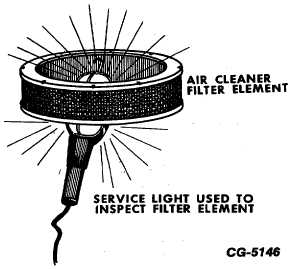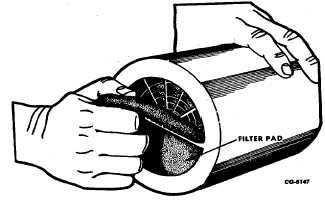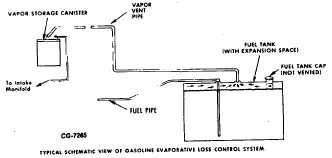|
| |
ENGINE DIVISION SERVICE MANUAL
TM 5-4210-230-14&P-1
to outside. Check element for punctures or splits by
looking through filter paper toward light held in center
of element. Do not wash element. Replace with new
element, if necessary.
Fig. 7 Dry Type Air Cleaner Filter
b.
Foam Wrap Dry Type Remove air cleaner element
assembly, clean any accumulation of dirt from air
cleaner housing. Remove foam wrap from element,
and tap element lightly on a flat surface or use low
air pressure to remove dirt particles. Blow air from
inside filter element to outside. Check element for
punctures or splits by looking through filter paper
toward light held in center of element. Do not wash
element. Replace with new element, if necessary.
Wash foam wrap in soap and water and dry with
compressed air. Submerge foam wrap in light
engine oil and squeeze excess oil from wrap.
Replace damaged wrap, if necessary. Install foam
wrap on element and reassemble air cleaner.
c.
Oil Bath Type - Remove air cleaner from engine.
Remove oil sump and drain oil. Wash sump and
mesh filter element in solvent and dry with
compressed air. Refill sump and oil mesh element
with engine oil of same viscosity used in the engine.
Allow excess oil to drip from element before
reassembly. Reinstall air cleaner.
7. Replace Filter at Bottom of Evaporative Vapor Storage
Canister (where used).
The air filter located at the bottom of the vapor
storage canister (Fig. 8) should be replaced at the interval
shown on the Maintenance Intervals Chart, or more frequently
under severe dusty conditions.
Fig. 8 Vapor Storage Canister Air Filter Location
7A. Gasoline Evaporative Loss Control System
In compliance with California air pollution control
regulations, all IH gasoline powered vehicles sold in California
will utilize gasoline evaporative loss control system which
reduces the amount of gasoline vapors entering the
atmosphere from the vehicle's fuel system. Below is a
schematic view of a typical gasoline evaporative loss control
system.
Fig. 9 Typical Schematic View of Fuel Tank Gasoline
Evaporative Loss Control System
To accomplish evaporative control the system must
perform three basic functions:
CGES-215 Page 9
PRINTED IN UNITED STATES OF AMERICA
|



